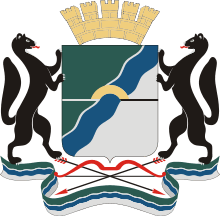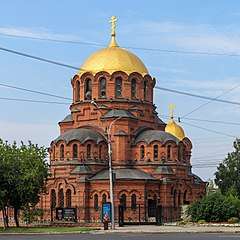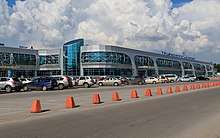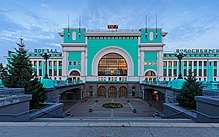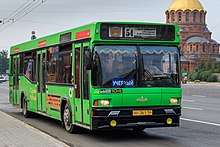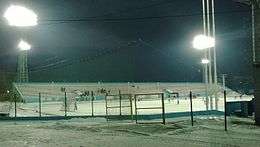Novosibirsk
Novosibirsk (/ˌnoʊvəsɪˈbɪərsk, -voʊs-/, also UK: /ˌnɒv-/;[19][20] Russian: Новосиби́рск, IPA: [nəvəsʲɪˈbʲirsk] (![]()
Novosibirsk Новосибирск | |
|---|---|
City[1] | |
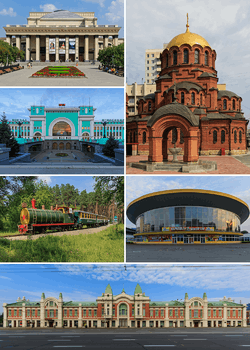 Clockwise: Alexander Nevsky Cathedral, the Circus, the Trade House, the Children's Railway, the Railway station, the Opera and Ballet Theater | |
 Flag | |
| Anthem: none[2] | |
Location of Novosibirsk 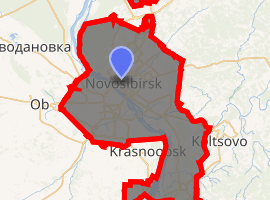
| |
 Novosibirsk Location of Novosibirsk 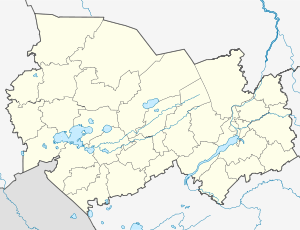 Novosibirsk Novosibirsk (Novosibirsk Oblast) | |
| Coordinates: 55°03′N 82°57′E | |
| Country | Russia |
| Federal subject | Novosibirsk Oblast[3] |
| Founded | 1893[4] |
| City status since | January 10, 1904 [O.S. December 28, 1903][5] |
| Government | |
| • Body | Council of Deputies[6] |
| • Head (Mayor)[6] | Anatoly Lokot[7] |
| Area | |
| • Total | 502.7 km2 (194.1 sq mi) |
| Elevation | 150 m (490 ft) |
| Population | |
| • Total | 1,473,754 |
| • Estimate (2018)[10] | 1,612,833 (+9.4%) |
| • Rank | 3rd in 2010 |
| • Density | 2,900/km2 (7,600/sq mi) |
| • Capital of | Novosibirsk Oblast[3], City of Novosibirsk[11] |
| • Urban okrug | Novosibirsk Urban Okrug[12] |
| • Capital of | City of Novosibirsk[13], Novosibirsky Municipal District[14] |
| Time zone | UTC+7 (MSK+4 |
| Postal code(s)[16] | List
630000, 630001, 630003–630005, 630007–630011, 630015, 630017, 630019, 630020, 630022, 630024, 630025, 630027–630030, 630032–630037, 630039–630041, 630045–630049, 630051, 630052, 630054–630061, 630063, 630064, 630066, 630068, 630071, 630073, 630075, 630077–630080, 630082–630084, 630087–630092, 630095–630100, 630102, 630105–630112, 630114, 630116, 630117, 630119–630121, 630123, 630124, 630126, 630128, 630129, 630132, 630133, 630136, 630200, 630201, 630700, 630880, 630885, 630890, 630899–630901, 630910, 630920–630926, 630970–630978, 630980–630983, 630985, 630988, 630989, 630991–630993, 901026, 901036, 901073, 901076, 901078, 901095, 901243, 901245, 901246, 991214 |
| Dialing code(s) | +7 383[17] |
| OKTMO ID | 50701000001 |
| City Day | Last Sunday of June[18] |
| Website | www |
Novosibirsk was founded in 1893 on the Ob River crossing point of the future Trans-Siberian Railway. Originally named Novonikolayevsk, it grew rapidly into a major transport, commercial and industrial hub. The city was ravaged by the Russian Civil War but recovered during the early Soviet period, and gained its present name in 1926. Under Stalin, Novosibirsk became one of the largest industrial centers of Siberia. Following the outbreak of World War II the city hosted many factories relocated from European Russia.
Novosibirsk is home to the headquarters of numerous Russian corporations, as well as the world-renowned Novosibirsk Zoo. It is served by Tolmachevo Airport, the busiest airport in Siberia.[23]
History
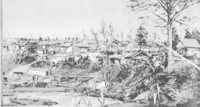
Novosibirsk, founded in 1893[4] at the future site of a Trans-Siberian Railway bridge crossing the great Siberian river of Ob, was at first named Novonikolayevsk (Новониколаевск),[5] in honor both of Saint Nicholas and of the reigning Tsar Nicholas II. It superseded nearby Krivoshchekovskaya village, which was founded in 1696. The bridge was completed in the spring of 1897, making the new settlement the regional transport hub. The importance of the city further increased with the completion of the Turkestan–Siberia Railway in the early 20th century. The new railway connected Novonikolayevsk to Central Asia and the Caspian Sea.[24]
At the time of the bridge's opening, Novonikolayevsk had a population of 7,800 people. The frontier settlement developed rapidly. Its first bank opened in 1906, and a total of five banks were operating by 1915. In 1907, Novonikolayevsk, now with a population exceeding 47,000, was granted town status with full rights for self-government. During the pre-revolutionary period, the population of Novonikolayevsk reached 80,000. The city had steady and rapid economic growth, becoming one of the largest commercial and industrial centers of Siberia. It developed a significant agricultural processing industry,[25] as well as a power station, iron foundry, commodity market, several banks, and commercial and shipping companies. By 1917, seven Orthodox churches and one Roman Catholic Church had been built there, along with several cinemas, forty primary schools, a high school, a teaching seminary, and the Romanov House non-classical secondary school. In 1913, Novonikolayevsk became one of the first places in Russia to institute compulsory primary education.[24]
The Russian Civil War took a toll on the city. Wartime epidemics, especially that of typhus and cholera, claimed thousands of lives. In the course of the war, the Ob River Bridge was destroyed. For the first time in the city's history, the population of Novonikolayevsk began to decline. The Soviet Workers' and Soldiers' Deputies of Novonikolayevsk took control of the city in December 1917. In May 1918, the Czechoslovak Legion rose in opposition to the revolutionary government and, together with the White Guards, captured Novonikolayevsk. The Red Army took the city in 1919, retaining it throughout the rest of the Civil War.[24]
Novonikolayevsk began reconstruction in 1921 at the start of Lenin's New Economic Policy period. It was a part of Tomsk Governorate and served as its administrative center from December 23, 1919 to March 14, 1920. Between June 13, 1921 and May 25, 1925, it served as the administrative center of Novonikolayevsk Governorate, which was separated from Tomsk Governorate. The city was given its present name on September 12, 1926.[5]
When governorates were abolished, the city served as the administrative center of Siberian Krai until July 23, 1930, and of West Siberian Krai until September 28, 1937, when that krai was split into Novosibirsk Oblast and Altai Krai.[26] Since then, it has served as the administrative center of Novosibirsk Oblast.[26]
The Monument to the Heroes of the Revolution was erected in the center of the city and has been one of the chief historic sites (essentially every child had to visit the monument on school field trips during the Soviet years). Neglect in the 1990s while other areas were redeveloped helped preserve it in the post-Soviet era.
During Joseph Stalin's industrialization effort, Novosibirsk secured its place as one of the largest industrial centers of Siberia. Several massive industrial facilities were created, including the 'Sibkombain' plant, specializing in the production of heavy mining equipment. Additionally a metal processing plant, a food processing plant, and other industrial enterprises and factories were built, as well as a new power station. The great Soviet famine of 1932–33 resulted in more than 170,000 rural refugees seeking food and safety in Novosibirsk. They were settled in barracks at the outskirts of the city, giving rise to slums.[24]
Its rapid growth and industrialization led to Novosibirsk being nicknamed the "Chicago of Siberia".[27]
Tram rails were laid down in 1934, by which time the population had reached 287,000, making Novosibirsk the largest city in Siberia. The following year the original bridge over the Ob River was replaced by the new Kommunalny bridge.[24]
Between 1941 and 1942 more than 50 substantial factories were crated up and relocated from western Russia to Novosibirsk in order to reduce the risk of their destruction through war, and at this time the city became a major supply base for the Red Army. During this period the city also received more than 140,000 refugees.
The rapid growth of the city prompted the construction during the 1950s of a hydroelectric power station with a capacity of 400 megawatts,[28] necessitating the creation of a giant water reservoir, now known as the Ob Sea. As a direct result of the station's construction, vast areas of fertile land were flooded as were relic pine woods in the area; additionally, the new open space created by the reservoir's surface caused average wind speeds to double, increasing the rate of soil erosion.[24]
In the 1950s, the Soviet Government directed that a center for scientific research be built in Novosibirsk, and in 1957 the multi-facility scientific research complex of Akademgorodok was constructed about 30 km (19 mi) south of the city center. The Siberian Division of the Russian Academy of Sciences (formerly the Academy of Sciences of the Soviet Union) has its headquarters in Akademgorodok, and the town hosts more than 35 research institutes and universities, among them Novosibirsk State University, one of the top Russian schools in Natural Sciences and Mathematics. Although it possesses a fully autonomous infrastructure, Akademgorodok is administered by Novosibirsk.
On September 2, 1962, the population of Novosibirsk reached one million. At that time, it was the youngest city in the world with over a million people. Novosibirsk took fewer than seventy years to achieve this milestone.[29]
In 1979, work began on the Novosibirsk Metro Transit System, culminating in the opening of the first line in 1985.[24]
On August 1, 2008, Novosibirsk was in the center of the path of a solar eclipse, with a duration of 2 minutes and 20 seconds.
The city appeared in the 2019 game Metro Exodus.
Administrative and municipal status
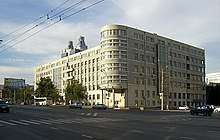
Novosibirsk is the administrative center of the oblast[3] and, within the framework of administrative divisions, it also serves as the administrative center of Novosibirsky District,[1] even though it is not a part of it.[11] As an administrative division, it is incorporated separately as the City of Novosibirsk[11]—an administrative unit with the status equal to that of the districts. As a municipal division, the City of Novosibirsk is incorporated as Novosibirsk Urban Okrug.[12]
City districts
- Dzerzhinsky (Дзержинский)
- Kalininsky (Калининский)
- Kirovsky (Кировский)
- Leninsky (Ленинский)
- Oktyabrsky (Октябрьский)
- Pervomaysky (Первомайский)
- Sovetsky (Советский)
- Tsentralny (Центральный)
- Zayeltsovsky (Заельцовский)
- Zheleznodorozhny (Железнодорожный)
Demographics
| 2010 Census | 1,473,754[9] |
|---|---|
| 2002 Census | 1,425,508[30] |
| 1989 Census | 1,436,516[31] |
| 1979 Census | 1,312,480[32] |
According to the Federal State Statistics Service, in January 2015 the number of residents came to 1,567,087.[33] This is an increase compared to the 2010 census, when the population of the city was 1,473,754.[9]
People from over eighty ethnicities and nationalities reside in Novosibirsk. The largest groups are Russian, Yakut, German, Ukrainian, Tatar, Jewish, and Belarusian.[34]
Ecology
Geography
Location
The city stands on the banks of the Ob River in the West Siberian Plain. To the south of the city lies the Priobskoye Plateau. The nearest major cities are Krasnoyarsk, Omsk and Nur-Sultan.
Climate
The climate in Novosibirsk is typical of Siberia, with dry winters and far-below-freezing winter temperatures. The reason for these temperatures is the absence of a nearby ocean, the Ural Mountains barring Atlantic air masses from reaching Siberia, and the lack of tall mountains at the north of Novosibirsk that could have held back freezing Arctic winds. In fact, Novosibirsk is the second-farthest substantially populated city from the ocean, the first being Ürümqi in China.
The climate is humid continental (Köppen Dfb), with warm summers and bitterly cold winters. Novosibirsk is frequently cloudy in the winter due to the collision of Atlantic and Siberian air masses. Snow is frequent, falling on almost half of all winter days, but individual snowfalls are usually light. On average temperatures range in summer from +15 °C (59 °F) to +26 °C (79 °F) and in winter from −20 °C (−4 °F) to −12 °C (10 °F). However, winter temperatures can go as low as −30 °C (−22 °F) to −35 °C (−31 °F), and summer temperatures can go as high as +30 °C (86 °F) to +35 °C (95 °F). The difference between the highest- and lowest-recorded temperatures is 82 °C (148 °F).
Travellers coming from countries with mild climates may find Novosibirsk's winter tough, but it may not be extraordinary for those from northern countries. At times, bitter cold may hold for some days, but temperatures of −40 °C (−40 °F) and lower do not occur every year.
| Climate data for Novosibirsk (1981–2010, extremes 1958–present) | |||||||||||||
|---|---|---|---|---|---|---|---|---|---|---|---|---|---|
| Month | Jan | Feb | Mar | Apr | May | Jun | Jul | Aug | Sep | Oct | Nov | Dec | Year |
| Record high °C (°F) | 4.1 (39.4) |
5.1 (41.2) |
14.4 (57.9) |
30.7 (87.3) |
36.1 (97.0) |
36.6 (97.9) |
36.4 (97.5) |
35.7 (96.3) |
33.2 (91.8) |
23.8 (74.8) |
11.7 (53.1) |
4.8 (40.6) |
36.6 (97.9) |
| Average high °C (°F) | −12.1 (10.2) |
−9.7 (14.5) |
−1.9 (28.6) |
8.1 (46.6) |
18.8 (65.8) |
23.4 (74.1) |
25.4 (77.7) |
22.9 (73.2) |
16.0 (60.8) |
7.7 (45.9) |
−3.4 (25.9) |
−10.0 (14.0) |
7.1 (44.8) |
| Daily mean °C (°F) | −16.5 (2.3) |
−14.8 (5.4) |
−7.6 (18.3) |
2.3 (36.1) |
11.8 (53.2) |
17.1 (62.8) |
19.4 (66.9) |
16.6 (61.9) |
10.2 (50.4) |
3.1 (37.6) |
−6.9 (19.6) |
−14.0 (6.8) |
1.7 (35.1) |
| Average low °C (°F) | −20.9 (−5.6) |
−19.5 (−3.1) |
−12.9 (8.8) |
−2.3 (27.9) |
5.6 (42.1) |
11.2 (52.2) |
13.8 (56.8) |
11.2 (52.2) |
5.6 (42.1) |
−0.4 (31.3) |
−10.3 (13.5) |
−18.4 (−1.1) |
−3.1 (26.4) |
| Record low °C (°F) | −46.2 (−51.2) |
−46.3 (−51.3) |
−36.4 (−33.5) |
−29 (−20) |
−8.6 (16.5) |
−2.0 (28.4) |
3.9 (39.0) |
0.2 (32.4) |
−6.9 (19.6) |
−26.4 (−15.5) |
−39.6 (−39.3) |
−45.7 (−50.3) |
−46.3 (−51.3) |
| Average precipitation mm (inches) | 25 (1.0) |
18 (0.7) |
17 (0.7) |
27 (1.1) |
34 (1.3) |
55 (2.2) |
66 (2.6) |
60 (2.4) |
43 (1.7) |
45 (1.8) |
37 (1.5) |
33 (1.3) |
459 (18.1) |
| Average rainy days | 1 | 1 | 2 | 8 | 13 | 14 | 14 | 14 | 16 | 12 | 5 | 1 | 101 |
| Average snowy days | 23 | 19 | 15 | 9 | 3 | 0.1 | 0 | 0 | 1 | 11 | 20 | 25 | 126 |
| Average relative humidity (%) | 82 | 81 | 77 | 65 | 58 | 66 | 73 | 75 | 75 | 78 | 83 | 83 | 75 |
| Mean monthly sunshine hours | 67 | 107 | 166 | 213 | 264 | 302 | 304 | 245 | 170 | 100 | 58 | 45 | 2,041 |
| Source 1: Pogoda.ru.net[35] | |||||||||||||
| Source 2: Danish Meteorological Institute (sun, 1931–1960)[36] | |||||||||||||
| Climate data for Novosibirsk (1961-1990) | |||||||||||||
|---|---|---|---|---|---|---|---|---|---|---|---|---|---|
| Month | Jan | Feb | Mar | Apr | May | Jun | Jul | Aug | Sep | Oct | Nov | Dec | Year |
| Average high °C (°F) | −12.2 (10.0) |
−10.3 (13.5) |
−2.6 (27.3) |
8.1 (46.6) |
17.5 (63.5) |
24.0 (75.2) |
25.7 (78.3) |
22.2 (72.0) |
16.6 (61.9) |
6.8 (44.2) |
−2.9 (26.8) |
−8.9 (16.0) |
7.0 (44.6) |
| Daily mean °C (°F) | −16.2 (2.8) |
−14.7 (5.5) |
−7.2 (19.0) |
3.2 (37.8) |
11.6 (52.9) |
18.2 (64.8) |
20.2 (68.4) |
17.0 (62.6) |
11.5 (52.7) |
3.4 (38.1) |
−6.0 (21.2) |
−12.7 (9.1) |
2.4 (36.3) |
| Average low °C (°F) | −20.1 (−4.2) |
−19.1 (−2.4) |
−11.8 (10.8) |
−1.7 (28.9) |
5.6 (42.1) |
12.3 (54.1) |
14.7 (58.5) |
11.7 (53.1) |
6.4 (43.5) |
0.0 (32.0) |
−9.1 (15.6) |
−16.4 (2.5) |
−2.3 (27.9) |
| Average precipitation mm (inches) | 19 (0.7) |
14 (0.6) |
15 (0.6) |
24 (0.9) |
36 (1.4) |
58 (2.3) |
72 (2.8) |
66 (2.6) |
44 (1.7) |
38 (1.5) |
32 (1.3) |
24 (0.9) |
442 (17.4) |
| Source: "Mean monthly climatic data for the city of Novosibirsk from 1961 to 1990". Roshydromet. Retrieved October 17, 2010. | |||||||||||||
Broadcasting
Novosibirsk is home to Russia's most powerful shortwave relay station east of the Ural mountains. This relay station can reach most of South Asia, the Middle East, and China. The Magadan and Vladivostok relay stations when operated in conjunction with Novosibirsk can guarantee that the Voice of Russia or any other broadcaster renting time at Novosibirsk is heard in the intended target area.
Transportation
International and intercity transportation
Airports
The city is served by Novosibirsk Tolmachevo Airport. Tolmachevo is the hub for S7 Airlines. There is also the auxiliary Yeltsovka Airport. A smaller field for general aviation at Novosibirsk Severny Airport was closed in 2012.
The many regular flights from Tolmachevo Airport connect Novosibirsk with most Russian largest cities and most countries of Europe and Asia.
Railway stations
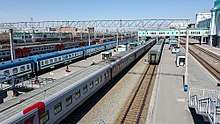
Novosibirsk is a major stop on the Trans-Siberian Railway and the north end of Turkestan–Siberia Railway. The main railway station of Novosibirsk is Novosibirsk-Glavny station ("Glavny" means "Main") which is located in the centre of the right bank part of the city. There are also Novosibirsk-Zapadny ("Zapadny" means "Western"), Novosibirsk-Vostochny ("Vostochny" means "Eastern"), and Novosibirsk-Yuzhny ("Yuzhny" means "Southern") railway stations in Novosibirsk. All intercity trains passing through the aforementioned stations stop at these stations. In addition, there are halts where only suburban trains stops, for example Inskaya, Seyatel, Razyezd Inya, and many others.
The many regular intercity trains connect Novosibirsk with Russian cities in Siberia, the Far East, Ural, and European Russia. International trains allow to get to China, Mongolia, Belarus, and countries in Central Asia.
Bus stations
The old Novosibirsk Bus Station located on Krasny Avenue in the right bank part of the city near Kommunalny Bridge was opened in 1964 and eventually closed on 6 April 2020.[37] There is a plan to build some new bus stations on the periphery of the city; the first of these new bus stations was built on Gusinobrodskoe Сhaussee and was opened on 18 December 2019.[38] Until the completion of remaining new bus stations, some bus stops in the city are being used by intercity bus services.
The many regular intercity/international bus routes connect Novosibirsk with most cities of the southern part of Western Siberia and major cities of Central Asia.
River passenger terminals
The building of Novosibirsk river passenger terminal (Russian: Речной вокзал) on the Ob river was opened in 1974.[39] Later, the self-titled metro station was opened near the building of the terminal. On March 7, 2003, there was the strong fire in the building of the terminal.[40] The part of the building was beyond repair and was demolished.
At present day, only one regular passenger line is operational: Novosibirsk - Kudryash island - Yagodnaya - Cheremushki - Novaya Zarya - Bibikha - Sedova Zaimka. There are also cruises on the Ob river and the Novosibirsk Reservoir including to Tomsk and Barnaul.
Usually, the period of navigability is opened in late April or early May and is closed in late September or early October.
City public transportation
Metro
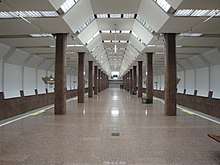
Сhronologically, Novosibirsk is the fourth city in Russia (after Moscow, Saint Petersburg, and Nizhny Novgorod) and the first city in Siberia in which a metro system was established: the Novosibirsk Metro was opened in 1985.
Tram system
The Novosibirsk tram system was launched in 1934.
- BKM-60103 tram
 71-623 (UKVZ) tram
71-623 (UKVZ) tram Tatra KT4DM tram
Tatra KT4DM tram Tram lines map (2018)
Tram lines map (2018)
Trolleybus system
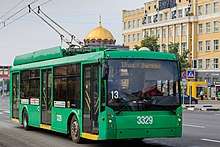
The Novosibirsk trolleybus system was launched in 1957.
Route taxi
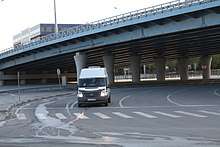
Marshrutkas (route taxis) have operated in Novosibirsk since the 1990s.
Waterbus system
The Novosibirsk waterbus system includes 2 routes: Novosibirsk river passenger terminal - Novosibirsk Waterpark and Novosibirsk river passenger terminal - Beach "Bugrinskaya Roshcha" - Korablik island.
Usually, the period of navigability is opened in late April or early May and is closed in late September or early October.
Economy
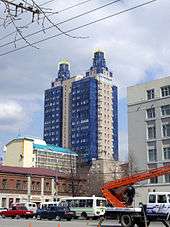
Novosibirsk is a large industrial center. The industrial complex consists of 214 large and average sized industrial enterprises. These produce more than two thirds of all industrial output of the Novosibirsk region. Leading industries are aerospace (Chkalov's Novosibirsk Aircraft Plant), nuclear fuel (Novosibirsk Chemical Concentrates Plant), turbo and hydroelectric generators (NPO ELSIB), textile machinery (Textilmach), agriculture machinery (NPO "Sibselmash"), electronics components and devices production (Novosibirsk Factory and Design Bureau of Semiconductor Devices NZPP, OXID Novosibirsk Plant of Radio components), and metallurgy and metal working (Kuzmina's Novosibirsk Metallurgical Plant, Novosibirsk Tin Plant OJSC, and JSC Plant of Rare Metals).
According to the television station RBC, Novosibirsk took third place in 2008 in the list of Russian cities most attractive to businesses (in 2007 it was placed thirteenth).
Before the relocation of its headquarters to Ob, S7 Airlines had its head office in Novosibirsk.[41]
The headquarters of a number of large Russian companies are located in Novosibirsk:[42]
- RATM Holding
- Antonov (Aircraft company) NAPO named after Chkalov
- Belon
- Center of Financial Technologies
- The Siberian coast Food Company (until 2009)
- NETA IT Company (retail, system integrator, software sales)
- Parallels IT Company (software for virtualization)
- Inmarko Food Company
- Siberian Food Corporation
- Electro-vacuum plant (the largest glass bottle factory in the Asian part of the country)
- NPO NIIIP-NZiK
- 2GIS
Sports
.jpg)
Several professional sports clubs are active in the city:
| Club | Sport | Founded | Current league | League rank | Stadium |
|---|---|---|---|---|---|
| FC Novosibirsk | Football | 1936 | Russian Professional Football League | 3rd | Spartak Stadium |
| Sibir Novosibirsk | Ice hockey | 1962 | Kontinental Hockey League | 1st | Ice Sports Palace Sibir |
| Sibselmash Novosibirsk | Bandy | 1937 | Russian Bandy Super League | 1st | Sibselmash Stadium |
| BC Novosibirsk | Basketball | 2011 | Basketball Super League | 2nd | SKK Sever |
| Dynamo-GUVD Novosibirsk | Basketball | 1955 | Women's Basketball Premier League | 1st | SKK Sever |
| Lokomotiv Novosibirsk | Volleyball | 1977 | Volleyball Super League | 1st | SKK Sever |
| Sibiryak Novosibirsk | Futsal | 1988 | Futsal Super League | 1st | NSAAA Sports Hall |
Novosibirsk is the home town of several former Olympians, including Aleksandr Karelin, a twelve-time world Greco-Roman wrestling champion who has been voted the greatest Greco-Roman wrestler of the twentieth century by FILA.
The city also hosts a number of National and International Ice Speedway events. Siberia Novosibirsk competed in the Russian Ice Speedway Premier League in 2012/13, and will do so again in 2013/2014.
Music
Several contemporary classical violinists, such as Vadim Repin, the late Alexander Skwortsow, Natalia Lomeiko, and Maxim Vengerov, are natives of Novosibirsk. Also born in the city were punk legend, poet and singer-songwriter Yanka Dyagileva, tragic punk rocker Dmitry Selivanov, folk/folk-rock singer Pelageya Khanova, and cellist Tatjana Vassiljeva. The career of poet and singer-songwriter Tatyana Snezhina is connected with Novosibirsk.
The city possesses the Novosibirsk State Conservatory, named in honor of the composer Mikhail Glinka; Novosibirsk State Philharmony, home to Novosibirsk Academic Symphony Orchestra, Novosibirsk Philharmonic Chamber Orchestra, Russian Academic Orchestra of Folk Instruments, and other musical groups; Novosibirsk Opera and Ballet Theater; and several notable music venues.
Education
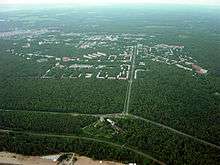
Novosibirsk is home to the following institutions of higher education:
- Novosibirsk State University (1959)
- Novosibirsk State Technical University (1950)
- Novosibirsk State University of Economics and Management (1929)
- Novosibirsk State Agricultural University (1936)
- Novosibirsk State University of Architecture, Design and Arts named after A.D. Kryachkov (1989)
- Novosibirsk State University of Architecture and Civil Engineering (1930)
- Novosibirsk State Medical University (1935)
- Novosibirsk State Pedagogical University (1935)
- Novosibirsk State Theater Institute (1960)
- Novosibirsk State Conservatory named after M.I. Glinka (1956)
- Novosibirsk Higher Military Command School of the Ministry of Defence of the Russian Federation (1967)
- Novosibirsk Military Institute named after I.K. Yakovlev of the National Guard Forces Command of the Russian Federation (1971)
- Novosibirsk Institute of the Federal Security Service of the Russian Federation (1935)
- Siberian State Transport University (1932)
- Siberian State University of Water Transport (1951)
- Siberian State University of Geosystems and Technologies (1933)
- Siberian State University of Telecommunications and Information Sciences (1953)
- Siberian Institute of Management of the Russian Presidential Academy of National Economy and Public Administration (1991)
- Siberian Institute of International Relations and Regional Studies (1998)
- Siberian University of Comsumer Cooperation (1956)
- Siberian Academy of Finance and Banking (1992)
Additionally, there are more than 50 vocational schools in Novosibirsk.
Akademgorodok is a remote part of Novosibirsk dedicated to science. It houses the Siberian branch of the Russian Academy of Sciences and is the location of Novosibirsk State University and Novosibirsk Higher Military Command School. All other higher education institutions are located in the central part of the city of Novosibirsk on the both banks of Ob river.
The Quality Schools International QSI International School of Novosibirsk, previously located in Akademgorodok, opened in 2008.[43]
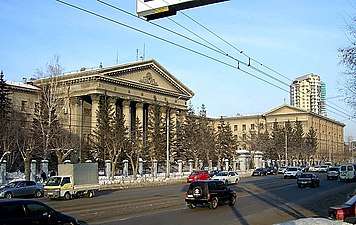
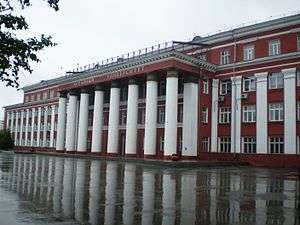
- Novosibirsk State Technical University, Main Building
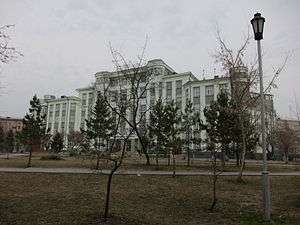 Siberian State University of Water Transport
Siberian State University of Water Transport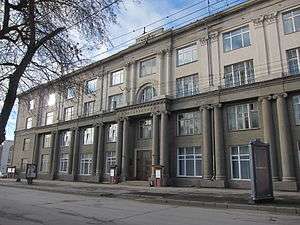 Novosibirsk State Conservatory named after M.I. Glinka
Novosibirsk State Conservatory named after M.I. Glinka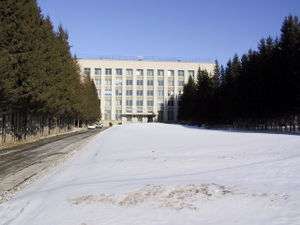
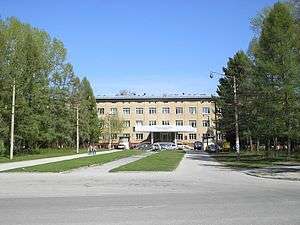 Lavrentyev Institute of Hydrodynamics, Siberian Branch of the Russian Academy of Sciences
Lavrentyev Institute of Hydrodynamics, Siberian Branch of the Russian Academy of Sciences- Technopark in Akademgorodok
Culture
Libraries
There are many libraries in Novosibirsk. The most significant libraries are the following:
- State Public Scientific & Technological Library
- Novosibirsk State Regional Scientific Library
- Novosibirsk Regional Special Library for the blind and visually impaired
Theatres
- Novosibirsk Opera and Ballet Theatre (1945)
- Novosibirsk Regional Puppet Theatre (1933)
- Novosibirsk State Drama Theatre "Old House" (1933)
- Novosibirsk State Academic Drama Theatre "Red Torch" (1932), directed by Timofey Kulyabin since 2015[44]
- Novosibirsk Academic Youth Theatre "Globe" (1930)
- Novosibirsk Musical Theatre (1959)
- Novosibirsk City Theatre under the direction of Sergey Afanasiev (1988)
- Novosibirsk Drama Theatre "On the left bank" (1997)
- Novosibirsk Studio Theatre "First Theatre" (2009)
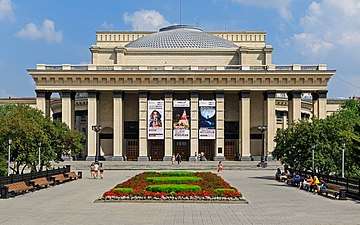
- Novosibirsk State Drama Theatre "Old House"
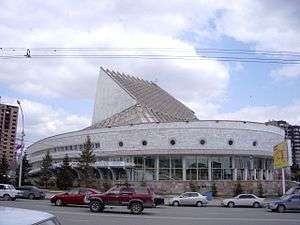
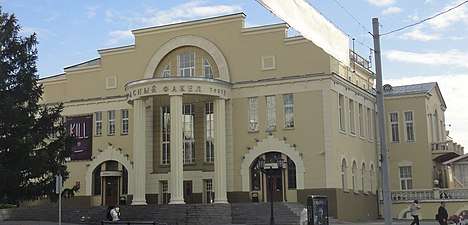 Novosibirsk State Academic Drama Theatre "Red Torch"
Novosibirsk State Academic Drama Theatre "Red Torch"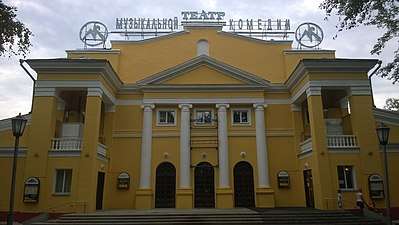 Novosibirsk Musical Theatre
Novosibirsk Musical Theatre
Philharmonic
Novosibirsk State Philharmonic Society was founded in 1937. It holds about 60 concerts per month using the following halls:
- Arnold Kats State Concert Hall (2013)
- Philharmonic Chamber Hall (1985)
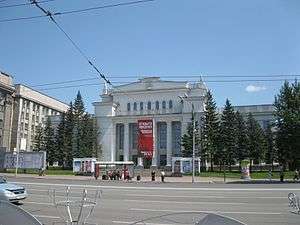 Philharmonic Chamber Hall of the Novosibirsk State Philharmonic Society
Philharmonic Chamber Hall of the Novosibirsk State Philharmonic Society
Cinemas
16 cinemas, including Cinema Park which supports IMAX and IMAX 3D.
Museums
- Novosibirsk State Art Museum
- Novosibirsk State Museum of Local Lore
- Museum of Cossacks glory
- Novosibirsk museum of railway equipment named after N.A. Akulinin
- Museum "Siberian Birch Bark"
- Nicholas Roerich Museum
- Museum of the Sun
- Historical and Architectural Museum in the open air
- Siberian Memorial Art Gallery
Planetarium
Novosibirsk Planetarium (2012)[45] was awarded in 2015 as the best social infrastructure object in Russia.[46]
Botanical Garden
Central Siberian Botanic Garden[47] is located in Akademgorodok.
Annual Festivals, Forums and Conferences
- Siberian Snow Sculpture Festival
- Transsiberian Art Festival
- Monstration
- Festival of children's animation films "Firebird"
- Festival of Youth Subcultures "ZNАКИ"
- Siberian Astronomical Forum
- Documentary Film Festival "Meetings in Siberia"
- Festival of Russian Music "Pokrovskaya autumn"
- International conference for lawyers "SibLegalWeek"
- Sib Jazz Fest
- Science Fiction Festival "White Spot"
- Poetry Festival "Very New Miracle"
- International Christmas Festival of Arts
Novosibirsk Zoo

The Novosibirsk Zoo is a world-renowned scientific institution as well as a popular tourist attraction.
The zoo has over 11,000 animals from 738 species and is an active participant in thirty-two different captive breeding programmes for endangered species. Since 2016, the Center of oceanography and marine biology "Dolphinia" has been part of the zoo.[48]
On average, around 1.5 million people visit the zoo each year.[49]
Novosibirsk Children's railway
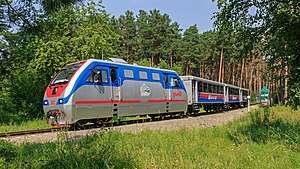
Small West Siberian Railway is the children's railway located in Zayeltsovsky Park.
It has 5 stations: Zayeltsovskiy Park, Razyezd Lokomotiv, Sportivnaya, Razyezd Eltsovskiy, Zoopark.
The railway is operational in summer.
Twin towns – sister cities
Novosibirsk is twinned with:[50]






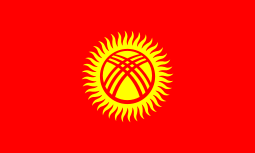






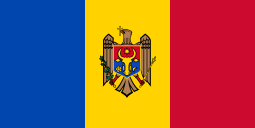
Notable residents
Violinist Mikhail Simonyan, playwright and prose writer Nina Mikhailovna Sadur, and three-time Olympic Greco-Roman wrestling champion Aleksandr Karelin were born and raised in Novosibirsk.
References
Notes
- Государственный комитет Российской Федерации по статистике. Комитет Российской Федерации по стандартизации, метрологии и сертификации. №ОК 019-95 1 января 1997 г. «Общероссийский классификатор объектов административно-территориального деления. Код 50 240», в ред. изменения №278/2015 от 1 января 2016 г.. (State Statistics Committee of the Russian Federation. Committee of the Russian Federation on Standardization, Metrology, and Certification. #OK 019-95 January 1, 1997 Russian Classification of Objects of Administrative Division (OKATO). Code 50 240, as amended by the Amendment #278/2015 of January 1, 2016. ).
- Article 5 of the Charter of Novosibirsk lists a flag and a coat of arms but not an anthem among the symbols of the city.
- Charter of Novosibirsk Oblast, Article 5
- Official website of Novosibirsk. History Archived August 19, 2009, at the Wayback Machine (in Russian)
- Charter of Novosibirsk, Article 1.1
- Charter of Novosibirsk, Article 27
- Official website of Novosibirsk. Anatoly Yevgenyevich Lokot Archived August 27, 2009, at the Wayback Machine, Mayor of Novosibirsk (in Russian)
- Official website of Novosibirsk. General Information Archived October 22, 2015, at the Wayback Machine (in Russian)
- Russian Federal State Statistics Service (2011). "Всероссийская перепись населения 2010 года. Том 1" [2010 All-Russian Population Census, vol. 1]. Всероссийская перепись населения 2010 года [2010 All-Russia Population Census] (in Russian). Federal State Statistics Service.
- http://www.gks.ru/free_doc/doc_2018/bul_dr/mun_obr2018.rar; archive date: 26 July 2018; retrieved: 25 July 2018; archive URL: https://web.archive.org/web/20180726010024/http://www.gks.ru/free_doc/doc_2018/bul_dr/mun_obr2018.rar.
- Государственный комитет Российской Федерации по статистике. Комитет Российской Федерации по стандартизации, метрологии и сертификации. №ОК 019-95 1 января 1997 г. «Общероссийский классификатор объектов административно-территориального деления. Код 50 401», в ред. изменения №278/2015 от 1 января 2016 г.. (State Statistics Committee of the Russian Federation. Committee of the Russian Federation on Standardization, Metrology, and Certification. #OK 019-95 January 1, 1997 Russian Classification of Objects of Administrative Division (OKATO). Code 50 401, as amended by the Amendment #278/2015 of January 1, 2016. ).
- Law On the Status and the Borders of the Municipal Formations of Novosibirsk Oblast
- Федеральная служба государственной статистики. Федеральное агентство по технологическому регулированию и метрологии. №ОК 033-2013 1 января 2014 г. «Общероссийский классификатор территорий муниципальных образований. Код 50 701». (Federal State Statistics Service. Federal Agency on Technological Regulation and Metrology. #OK 033-2013 January 1, 2014 Russian Classification of Territories of Municipal Formations. Code 50 701. ).
- Law On the Administrative Centers of the Municipal Districts and Rural Settlements of Novosibirsk Oblast
- "Об исчислении времени". Официальный интернет-портал правовой информации (in Russian). June 3, 2011. Retrieved January 19, 2019.
- Почта России. Информационно-вычислительный центр ОАСУ РПО. (Russian Post). Поиск объектов почтовой связи (Postal Objects Search) (in Russian)
- "International Dialing Codes - how to call from Hong Kong – Hong Kong to Russia – Novosibirsk – Novosibirsk".
- Charter of Novosibirsk, Article 1
- Wells, John C. (2008). Longman Pronunciation Dictionary (3rd ed.). Longman. ISBN 978-1-4058-8118-0.
- Roach, Peter (2011). Cambridge English Pronouncing Dictionary (18th ed.). Cambridge: Cambridge University Press. ISBN 978-0-521-15253-2.
- Новосибирская ГЭС. Вокруг здания ГЭС, водосливная плотина :: Gelio | Слава Степанов Archived August 8, 2013, at the Wayback Machine. Gelio.newsib.ru. Retrieved on 2013-08-16.
- "Численность населения по муниципальным районам и городским округам Новосибирской области на 1 января 2018 года и в среднем за 2017 год" (PDF). Novosibirsk Oblast Territorial Branch of the Federal State Statistics Service. Archived from the original (PDF) on August 23, 2018. Retrieved April 21, 2020.
- "European Airport Traffic Trends". Aviation database bank, free of charge from anna.aero. Retrieved June 22, 2018.
- AllSiberia
- "Сельское хозяйство :: Бизнес-журнал, новости Новосибирска и Новосибирской области". Biz.newsib.ru. Archived from the original on February 24, 2013. Retrieved March 12, 2013.
- Decision of Central Execution Committee of USSR dated 28 of September of 1937 (link to law base provided by official legal service "Consultant Plus")
- "From Novosibirsk to Komsomolsk". TIME. May 4, 1942. Retrieved May 6, 2009.
- "Novosibirsk, Siberia, Russia History & Info". Utopiasprings.com. Retrieved May 6, 2009.
- "Novosibirsk Mayor Office Web Site, City History Page". Novosibirsk Mayor Office. Archived from the original on March 7, 2008. Retrieved February 13, 2008.
- Russian Federal State Statistics Service (May 21, 2004). "Численность населения России, субъектов Российской Федерации в составе федеральных округов, районов, городских поселений, сельских населённых пунктов – районных центров и сельских населённых пунктов с населением 3 тысячи и более человек" [Population of Russia, Its Federal Districts, Federal Subjects, Districts, Urban Localities, Rural Localities—Administrative Centers, and Rural Localities with Population of Over 3,000] (XLS). Всероссийская перепись населения 2002 года [All-Russia Population Census of 2002] (in Russian).
- "Всесоюзная перепись населения 1989 г. Численность наличного населения союзных и автономных республик, автономных областей и округов, краёв, областей, районов, городских поселений и сёл-райцентров" [All Union Population Census of 1989: Present Population of Union and Autonomous Republics, Autonomous Oblasts and Okrugs, Krais, Oblasts, Districts, Urban Settlements, and Villages Serving as District Administrative Centers]. Всесоюзная перепись населения 1989 года [All-Union Population Census of 1989] (in Russian). Институт демографии Национального исследовательского университета: Высшая школа экономики [Institute of Demography at the National Research University: Higher School of Economics]. 1989 – via Demoscope Weekly.
- "Всесоюзная перепись населения 1979 г. Национальный состав населения по регионам России" [All Union Population Census of 1979. Ethnic composition of the population by regions of Russia] (XLS). Всесоюзная перепись населения 1979 года [All-Union Population Census of 1979] (in Russian). 1979 – via Demoscope Weekly (website of the Institute of Demographics of the State University—Higher School of Economics.
- "Численность населения по муниципальным районам и городским округам Новосибирской области на 1 января 2015 года и в среднем за 2014 год" (PDF) (in Russian). Novosibirsk Oblast Territorial Branch of the Federal State Statistics Service. Archived from the original (PDF) on March 4, 2016. Retrieved October 22, 2015.
- Официальный сайт города Новосибирска: Archived May 20, 2013, at the Wayback Machine. English.novo-sibirsk.ru. Retrieved on 2013-08-16.
- "Weather and Climate-The Climate of Novosibirsk" (in Russian). Weather and Climate. Retrieved May 11, 2020.
- Cappelen, John; Jensen, Jens. "Rusland - Novosibirsk" (PDF). Climate Data for Selected Stations (1931-1960) (in Danish). Danish Meteorological Institute. p. 225. Archived from the original (PDF) on April 27, 2013. Retrieved April 7, 2017.
- "Автовокзал на Красном проспекте прекращает работу". vn.ru. Retrieved May 5, 2020.
- "Новый автовокзал открыли на Гусинобродском шоссе в Новосибирске". vn.ru. Retrieved May 5, 2020.
- Баландин, Сергей Николаевич (1986). Новосибирск : История градостроительства 1945-1985 гг. Новосибирск: Книжное издательство. Retrieved May 5, 2020.
- "11.03.2003 Новосибирская область: Речной вокзал в областном центре сгорел из-за непотушенного окурка и восстановлению не подлежит". REGNUM News Agency.
- "World Airline Directory." Flight International. March 30 - April 5, 2004. 68.
- "Siberian business portal KSONLINE .
- "Home." QSI International School of Novosibirsk. October 2, 2009. Retrieved on May 15, 2016.
- "People". www.bolshoi.ru. Retrieved January 1, 2018.
- Детский Юношеский Центр "Планетарий" Archived February 15, 2015, at the Wayback Machine
- Ministry of Housing and Building of Russian Federation official website
- "Central Siberian Botanical Garden/Центральный сибирский ботанический сад СО РАН". bgci.org. Retrieved August 6, 2015.
- О центре океанографии и морской биологии "Дельфиния" (in Russian). Novosibirsk Center of oceanography and marine biology "Dolphinia" official page. Retrieved May 10, 2020.
- ИСТОРИЯ ЗООПАРКА (in Russian). Novosibirsk Zoo official page. Retrieved May 10, 2020.
- "Города-побратимы Новосибирска". novo-sibirsk.ru (in Russian). Novosibirsk. Retrieved February 3, 2020.
Sources
- Городской Совет Новосибирска. Решение №616 от 27 июня 2007 г. «Устав города Новосибирска», в ред. Решения №1311 от 31 марта 2015 г. «О внесении изменений в устав города Новосибирска, принятый Решением городского Совета Новосибирска от 27.06.2007 №616». Вступил в силу через 10 дней со дня официального опубликования, за исключением положений, для которых установлены иные сроки и порядок вступления в силу. Опубликован: "Бюллетень органов городского самоуправления Новосибирска", №58, стр. 3, 15 августа 2007 г. (City Council of Novosibirsk. Decision #616 of June 27, 2007 Charter of the City of Novosibirsk, as amended by the Decision #1311 of March 31, 2015 On Amending the Charter of the City of Novosibirsk Adopted by the Decision #616 of the City Council of Novosibirsk of June 27, 2007. Effective as of 10 days after the official publication date, with the exception of the clauses for which different dates and procedures of taking effect are specified.).
- Новосибирский областной Совет депутатов. Постановление №282-ОЗ от 31 марта 2005 г. «Устав Новосибирской области», в ред. Закона №529-ОЗ от 26 февраля 2015 г. «О поправках к Уставу Новосибирской области». Вступил в силу 1 мая 2005 г. Опубликован: "Советская Сибирь", №81, 29 апреля 2005 г. (Novosibirsk Oblast Council of Deputies. Resolution #282-OZ of March 31, 2005 Charter of Novosibirsk Oblast, as amended by the Law #529-OZ of February 26, 2015 On Amending the Charter of Novosibirsk Oblast. Effective as of May 1, 2005.).
- Новосибирский областной Совет депутатов. Закон №246-ОЗ от 17 декабря 2004 г. «Об административных центрах муниципальных районов и сельских поселений Новосибирской области», в ред. Закона №69-ОЗ от 5 декабря 2006 г. «О внесении изменений в Закон Новосибирской области "Об административных центрах муниципальных районов и сельских поселений Новосибирской области"». Вступил в силу со дня официального опубликования. Опубликован: "Советская Сибирь", №252, 29 декабря 2004 г. (Novosibirsk Oblast Council of Deputies. Law #246-OZ of December 17, 2004 On the Administrative Centers of the Municipal Districts and Rural Settlements of Novosibirsk Oblast, as amended by the Law #69-OZ of December 5, 2006 On Amending the Law of Novosibirsk Oblast "On the Administrative Centers of the Municipal Districts and Rural Settlements of Novosibirsk Oblast". Effective as of the official publication date.).
External links
![]()
